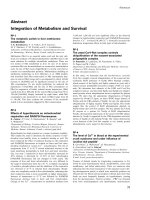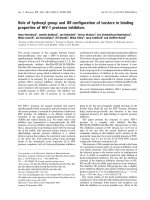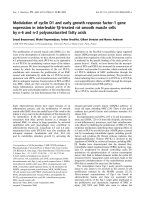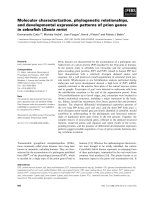Báo cáo khoa học: "Variability in beech : budding, and tree form technical coopera height growth" doc
Bạn đang xem bản rút gọn của tài liệu. Xem và tải ngay bản đầy đủ của tài liệu tại đây (944.33 KB, 16 trang )
Variability
in
beech :
budding,
height
growth
and
tree
form
E.
TEISSIER
DU
CROS
with
the
technical coopera
B.
THIEBAUT
of
H. DUVAL
*
H.
DUVAL
Arbres
foresti
*
INRA,
Station
d’Amélioration
des
Arbres
forestiers,
Centre
de
Recherches
d’Orléans,
Ardon,
F 45160
Olivet
**
U.S.T.L.,
Institut
de
Botanique,
163,
rue
Auguste-Broussonnet,
F
34000
Montpellier
and
C.N.R.S.,
Centre
Louis-Emberger,
BP
5051,
F34033
Montpellier
Cedex
Résumé
Variabilité
chez
le
hêtre :
débourrement
végétatif,
croissance
en
hauteur
et
forme
des
plants
Le
hêtre
est
planté
en
France
en
plein
ou
en
complément
de
régénération.
Le
choix
des
meilleures
sources
de
graines
est
basé
sur
l’établissement
d’expériences
comparatives
multistation-
nelles
de
provenances.
Un
tel
réseau
de
dispositifs
a
débuté
en
1976
avec
39 provenances
françaises
(tabl.
1
et
2,
fig.
3).
Les
trois
caractères
observés
ont
tous
un
impact
économique.
Un
débourrement
végétatif
tardif
est
recherché
pour
les
plantations
en
plein
découvert
à
basse
altitude
dans
des
sites
sensibles
aux
gelées
printannières.
Ce
caractère
est
sous
fort
contrôle
génétique,
il
est
stable
dans
le
temps
(fig.
4)
et
dans
l’espace
(fig.
5).
De
plus,
il
semble
soumis
à
une
légère
loi
de
variation.
Des
provenances
d’altitude
élevée
ont,
à
basse
altitude,
un
débourre-
ment
plus
précoce
que
des
peuplements
de
basse
altitude.
Cette
règle
n’est
pas
absolue
(fig.
6),
mais
les
observations
réalisées
dans
les
expériences
comparatives
de
provenance
ont
permis
de
déterminer
des
peuplements
à
débourrement
tardif.
La
vigueur,
diagnostiquée
ici
par
la
croissance
en
hauteur,
est
aussi
un
caractère
variable
(tabl.
3).
Son
déterminisme
génétique
n’est
pas
très
puissant
chez
le
hêtre
et
elle
est
soumise
à
une
forte
interaction
génotype-environnement.
Sauf
exception,
il
est
donc
difficile
de
trouver
des
provenances
vigoureuses
« passe-partout
».
Par
contre,
dans
un
milieu
donné,
la
différence
de
croissance
entre
la
provenance
la
plus
vigoureuse
et
la
provenance
la
moins
vigoureuse
atteint
dès
le
jeune
âge
l’équivalent
d’une
année
de
croissance.
Une
provenance
vigoureuse
a
donc
besoin
de
moins
de
dégagements
qu’une
provenance
moins
vigoureuse.
Croissance
en
hauteur
et
débourre-
ment
végétatif
sont
deux
caractères
indépendants
(tabl.
6).
La
fourchaison
du
hêtre
est
un
défaut
que
le
forestier
aimerait
corriger.
Elle
a
été
mesurée
sur
de
jeunes
hêtres
soit
en
comptant
le
nombre
de
rameaux
concurrençant
la
tige
principale
(fourches),
soit
en
mesurant
l’incidence
du
polycyclisme
sur
la
croissance
annuelle,
caractère
dont
on
sait
qu’il
peut
conduire
à
la
fourchaison.
Dans
certains
sites
expérimentaux
la
fourchaison,
surtout
lorsqu’elle
est
appréciée
par
l’incidence
du
polycyclisme
(fig.
1
et
2),
est
un
caractère
variable.
Mais
elle
est
aussi
très
dépendante
du
milieu
(pluviosité,
par
exemple).
Il
en
résulte
une
forte
intéraction
génotype-environnement.
La
fourchaison
semble
diminuer
avec
l’âge
(tabl.
4
et
5)
et
on
sait
que
des
plantations
denses
réduisent
aussi
le
risque
de
fourchaison.
Ces
facteurs
conduisent
tous
les
deux
à
une
augmentation
de
la
concurrence
entre
plants,
ce
qui
rejoint
l’hypothèse
faite
par
divers
auteurs
selon
laquelle
trop
d’abondance
pour
le
hêtre
(lumière,
espace,
eau,
fertilité)
peut
conduire
à
un
fort
polycyclisme
qui,
s’il
concerne
aussi
les
rameaux
latéraux,
peut
se
traduire
par
des
fourches.
La
conduite
des
peuplements
plantés
est
donc
très
délicate,
mais
doit
certainement
commencer
par
une
densité
de
plantation
relativement
supérieure
à
celle
qui
est
préconisée
actuellement
en
France.
Le
choix
de
provenances
à
la
fois
vigoureuses
et
peu
enclines
à
fourcher
est
difficile,
mais
néanmoins
faisable,
essai
par
essai.
Les
provenances
suivantes
ont
un
débourrement
végétatif
tardif
et
sont
au-dessus
de
la
moyenne
pour
la
vigueur
et
la
forme :
Chatillon,
Compiègne,
Sousceyrac
et
Perche-Trappe.
Mots
elé.s :
Fagus
sylvatica,
provenance,
variabilité,
phénologie,
croissance,
forme.
Summary
Three
types
of
characteristics
of
beech
with
an
economic
impact,
i.e.
flushing,
height
growth
and
forking,
have
been
studied
in
7
provenance
tests
laid
out
in
5
different
French
locations.
Bud
burst
is
under
strong
genetic
control.
Therefore
the
choice
of
late
flushing
provenances
which
will
resist
late
spring
frosts
is
possible.
Height
growth
and
forking
are
also
genetically
controlled
but
to
a
lesser
extent.
Site
effect
is
high
and
results
in
a
strong
genotype-site
interaction.
Therefore,
the
choice
of
provenances
with
a
high
vigour
and
without
forks,
two
genetically
independant
charac-
teristics,
will
need
careful
observation
in
regional
provenance
tests.
A
few
such
provenances
are
proposed.
Key
words :
Fagus
sylvatica,
provenance,
variability,
phenology,
height
growth,
tree
form.
1.
introduction
French
studies
on
beech
variability
were
initiated
in
1976
with
the
lay-out
of
a
multisite
series
of
provenance
tests.
First
results
concerned
soil-provenance
interaction
(L
EPOUTRE
&
T
EISSIER
DU
C
ROS
,
1979 ;
T
EISSIER
DU
C
ROS
&
L
EPOUTRE
,
1983),
and
form
and
architecture
of
young
beech
trees
in
connection
with
polycyclism
and
shoot
growth
(D
UPRE
et
al.,
1984,
1985,
1986).
Allozyme
electrophoretic
analysis
has
also
been
used
to
describe
genetic
variation
in
beech
within
its
range
and
more
specifically
in
the
Mediterranean
region
(TtttEB.nuT,
1984 ;
B
ARRI
T
RE
et
al.,
1985 ;
C
UGUEN
et
al.,
1985).
Finally,
work
on
the
spiral
grain
of
mature
trees
was
published
in
cooperation
with
a
German
team
(AzoEUF et
al.,
1980).
Since
planting,
a
series
of
observations
have
been
made
in
7 provenance
tests
(table
1).
They
concerned
bud
burst,
height
increment
and
tree
form.
Two
factors
were
to
be
studied :
genetic
variability
and
effect
of
plant
age.
2.
Materiais
and
methods
2.1.
Provenance
trials
Trial
sites
(table
1
and
fig.
3)
were
chosen
either
because
they
are
in
regions
where
reafforestation
with
beech
occurs
currently
(Ecouves,
Sommedieue,
Montagne
Noire)
or
because
they
belong
to
a
region
where
beech
would
have
a
great
potential
(western
slopes
of
Massif
Central :
Chaud),
or
because
they
were
at
hand
for
a
concentrated
series
of
observations
(Orléans).
2.2.
Provenances
They
were
sampled
in
French
beech
stands
which
had
been
either
selected
for
seed
production
or
were
unselected
(table 2).
These
stands
represent
most
types
of
site
conditions
where
beech
occurs
naturally
(fig.
3).
2.3.
Designs
The
Orléans
11
trial,
having
the
largest
number
of
provenances,
was
used
as
a
reference
for
the
estimation
of
provenance-site
interaction.
All
trials
consisted
of
complete
replications
of
all
the
provenances
they
included
(table
1).
The
main
charac-
teristics
and
the
location
of
the
7
provenance
trials
are
given
in
table
1
and
figure
3.
Trials
1
to
6
were
sown
in
the
same
nursery
of
INRA,
Nancy,
and
during
the
same
period.
2.4.
Observations
They
varied
according
to
trials,
but
they
generally
included :
!
Total
height
at
different
ages.
!
Stem
diameter
5
cm
above
ground
level.
< Number
of
branches
competing
with
the
terminal
shoot
leading
to
forks,
observed
with
the
empirical
«
forester’s
eye
».
e
Number
of
forks,
connected
to
growth
patterns
defined
in
previous
papers
(monopodial
+
sympodial
forked
shoot
growth),
considered
as
an
explanatory
observa-
tion
of
forking
habit
(T
HCE
anuT
et
al.,
1985 ;
D
UPRE
et
al.,
1986).
e
Ratio
of
orthotropic
growth
(Lammas
shoots)
on
total
shoot
growth
(plagio-
tropic
+
orthotropic)
(fig.
1
and
2).
One
must
remember
that
polycyclism
may
result
in
forking
when
concerning
lateral
shoots
or
when
taking
place
too
late
during
the
growing
season
(LE
TACON,
1983).
Consequently,
forking
has
been
approached
in
two
ways :
a
probabilistic
approach
and
an
architectural
approach.
e
Budding
in
spring
in
connection
with
susceptibility
to
late
frosts.
Budding
was
observed
by
two
techniques.
In
Orléans,
trees
were
considered
to
have
flushed,
the
day
when
their
terminal
bud
had
reached
a
particular
phenologie
stage
i.e.
the
beginning
of
elongation.
Each
year,
surveys
started
at
the
end
of
April.
The
first
survey
was
made
on
a
day
when
no
terminal
bud
had
yet
reached
that
phenologic
stage,
for
instance
Monday
April
25th.
Three
surveys
a
week
were
scheduled
until
all
trees
had
flushed
(usually
one
month
later).
Therefore,
a
tree
having
flushed
on
Wednesday
May
4th
was
given
the
value
9 days
and
a
tree
having
flushed
on
Friday
13th
received
the
value
18 days
(fig. 4,
abscissae
in
fig.
5 and
ordinates
of
fig.
6).
When
such
frequent
observations
were
impossible,
as
in
Eawy
(the
nursery
in
which
Ecouves
seedling
were
raised)
the
terminal
bud
of
each
seedling
was
observed
once
with
a
scale
ranging
from
1
referring
to
a
dormant
bud,
to
7
for
a
bud
whose
leaves
were
developed
with
a
beginning
of
stem
elongation
(ordinates
of
fig.
5).
Tests
on
these
variables
(number
of
days,
scale)
showed
that
they
could
both
could
be
considered
statistically
normal.
Evolution
of
traits
with
time.
Two
methods
were
used :
-
measuring
the
same
experiment
at
different
periods.
In
this
case
the
trees
are
exactly
the
same
apart
from
age,
but
environmental
conditions
vary
steadily
with
tree
height
growth
and
crown
expansion.
Environmental
conditions
may
also
vary
unpredict-
ably
because
of
temperature
and
rainfall.
All
trials
except
Sommedieue
and
Montagne
Noire
were
measured
during
the
winter
1983-1984
and
again
two
years
later ;
-
measuring
two
experiments
of
different
age,
with
common
provenances,
at
the
same
site.
In
this
case
apart
from
age
and
concomitant
plant
height
and
crown
diameter,
site
conditions
(soil,
climate)
are
exactly
the
same.
Simultaneous
observations
of
7
provenances
common
to
trials
Orléans
11
and
Orléans
2
were
made.
3. Results
3.1.
Trait
variabili
tv
(table
3)
Generally,
most
traits
observed
varied
between
provenances.
Exceptions
occur
when
the
provenance-replication
interaction
becomes
significant.
Budding
is
always
a
very
variable
trait.
At
Orléans
11,
the
difference
between
the
earliest
and
the
latest
provenance
is
10 days.
Budding
ranking
shows
stability
when
observed
in
different
years
(fig.
4),
and
at
different
locations
(fig.
5).
Finally
there
is
a
slight
tendency
in
late
flushing
provenances
to
originate
from
lower
elevations
than
early
flushing
ones
(fig.
6).
(table
2)
and
diameter
growth
variation
between
provenances
is
more
important
in
favourable
sites
than
in
harsh
sites.
As
an
illustration,
total
height
at
age
11
is
2.4
m
in
Chaud,
a
rich
site
with
high
rainfall,
and
3.8
m
in
Orléans
11,
where
trees
were
grown
in
nursery
conditions
with
fertilisation
and
irrigation.
In
contrast
height
at
age
11
is
only
1.6
m
in
Ecouves,
with
a
poor
and
shallow
soil,
and
1.0
m
in
Montagne
Noire,
a
site
stressed
by
drought
and
wind
in
summer
and
by
snow
in
winter.
Tree
architecture
varies
between
provenances
at
several
sites.
When
forking
is
assessed
with
the
« forester’s
eye »,
variation
only
appears
at
Orléans.
Elsewhere,
variation
is
always
hidden
by
a
change
of
provenance
ranking
between
replications
(interaction).
However,
when
the
growth
pattern
is
considered
in
forking
assessment,
using
explanatory
observations,
a
difference
between
provenances
also
appears
in
trials
like
Ecouves
and
Chaud
in
1984.
3.2.
Trait
evolution
with
time
a
Observation
of
the
same
experiments
at
a
2-year
interval.
Table
4
shows
a
slight
but
steady
decrease
in
forking
with
age.
Although
a
2-year
interval
might
be
considered
short
to
arrive
at
a
conclusion,
a
simultaneous
decrease
in
forking
in
five
different
trials
and
on
three
different
sites
is
observed.
e
Observation
of
seven
provenances
common
to
2
trials
of
different
ages.
The
comparison
of
seven
provenances
common
to
Orléans 11
(age 11)
and
Orléans
2
(age
8),
in
table
5,
shows
a
slight
although
not
significant
reduction
in
forking
and
a
strong
decrease
in
the
incidence
of
polycyclism
on
shoot
growth
with
increasing
age.
4.
Discussion
4.1.
Consequence
of
the
variability
In
all
trials
the
height
difference
between
the
most
vigorous
and
the
weakest
provenance
is
roughly
equivalent
to
a
one-year
terminal
shoot
length.
In
the
Orléans
11
trial,
which
has
been
measured
every
year
since
planting,
it
was
observed
that
this
same
difference
has
been
maintained
from
age
4
to
age
11.
Such
a
difference,
although
not
significant- when
trees
will
be
fully
developed,
is
of
great
economic
interest
in
young
trees.
A
vigorous
provenance
will
outgrow
competing
vegetation
quicker
than
a
weak
one.
Therefore
it
will
be
less
expensive
to
keep
this
vegetation
under
control
after
planting.
Budding
is
also
of
great
economic
importance.
In
many
regions,
beech
is
planted
without
shelter
and
young
plantations
suffer
from
late
frosts
occuring
after
budding
(T
EISSIER
DU
C
ROS
,
1981).
Meteorological
observations
made
at
a
weather
station
near
Orléans
show
that
a
10-day
delay
in
budding
during
a
period
ranging
from
late
April
to
early
May
decreases
frost
risk
by
50 percent.
Moreover,
as
flushing
is
not
correlated
with
height
growth
(table
6)
the
choice
of
late
flushing
provenances
appears
to
have
no
relationship
with
the
length
of
the
growing
season.
Our
observations
confirm
those
of
G
ALOUX
(1986)
who
found
in
progeny
tests
that
the
total
genetic
variance
represents
93 percent
of
the
variation.
Therefore,
as
for
many
other
forest
tree
species,
late
flushing
provenances
are
needed
for
low
elevation
plantations.
They
can
be
found
in
different
regions
such
as
the
northeastern
part
of
the
Seine
river
basin
(elevation
under
200
meters),
in
northeastern
France
(under
400
m)
and
in
the
southwestern
foothills
of
the
Massif
Central
mountains
(under
600 m).
Conversely,
early
flushing
provenances
are
found
in
high
elevation
stands :
Pyrénées,
Southern
Massif
Central
(over
500 m :
Aubrac
and
Montagne
Noire),
in
the
Vosges
foothills
(around
300
to
400
m)
and
also
in
northwestern
France
(below
150 m).
Unfortunately,
no
general
rule
can
be
given.
The
low
phenotypic
correlation
between
provenance
elevation
and
bud
burst
originates
partly
from
provenances
in
the
same
region
or
in
the
same
stand
which
appear
as
late
flushers
or
early
flushers.
As
it
is
impossible
to
compare
the
flushing
habit
of
different
stands
with
in
situ
observations
the
only
way
to
observe
flushing
ranking
is
in
comparative
tests.
Another
solution
is
of
course
to
find
methods
to
protect
young
trees
from
late
frosts
(lateral
or
overhead
shelters),
but
this
is
in
foresters’
hands.
Fairly
complete
information
has
been
already
given
in
other
papers
about
the
morphology
of
young
beech
trees
of
our
provenance
tests
in
connection
with
the
environment
and
the
genetic
variability
(D
UPRE
,
et
al.,
1985
and
1986).
Briefly,
stem
forking
appears
as
a
severe
defect
which
originates
mainly
from
the
simultaneous
polycyclic
growth
of
terminal
and
lateral
shoots
of
young
beech
trees.
The
variability
between
provenances
is
high
but
it
is
hidden
by
a
strong
genotype-site
interaction.
In
the
present
report
two
sets
of
information
have
been
given.
Stem
forking
cannot
be
estimated
accurately
from
the
number
of
existing
or
potential
forks
alone.
It
is
estimated
more
precisely
when
polycyclism
is
included
in
the
observations.
Therefore
results
obtained
by
the
probabilistic
approach
and
the
architec-
tural
approach
are
complementary.
Stem
forking
seems
to
decrease
when
trees
grow
taller.
The
main
factor
which
may
be
involved
in
forking
decrease
is
the
competition
between
trees.
Competition
acts
in
terms
of
space
occupation
and
the
interception
of
light
and
nutrients.
Competition
for
space
has
been
studied
in
Germany
in
a
provenance-spacing
trial
(M
UHLE
&
K
APPICH
,
1979).
At
age
15,
a
15
000
tree/ha
planting
density
produced
7
percent
of
forked
trees,
whereas
a
5
900
tree/ha
planting
density
produced
19
percent
of
forked
trees.
Competi-
tion
for
light
has
been
studied
by
D
UPRE
(1984)
in
naturally
regenerated
seedling
patches
in
beech
stands.
Full
light
increases
height
growth
as
compared
with
half
shelter
or
full
shelter
by
the
canopy
of
remaining
mature
trees.
Although
no
polycyclism
had
occurred
in
that
particular
case,
full
light
also
increased
the
forking
risk.
In
another
observation
reported
by
LE
TACON
(1983),
it
has
been
suggested
that
full
light
also
favours
polycyclism
and
potentially
forking
when
polycyclism
results
in
malformation
of
the
terminal
bud.
Our
provenance
tests
throw
some
light
on
the influence
of
competi-
tion
for
nutrients
on
forking.
The
total
height
growth
at
age
11
(see
§ 3-1)
suggests
that
the
Chaud
trial
occupies
a
rather
fertile
site.
Soil
fertility
probably
does
not
vary
much
from
one
year
to
the
next,
but
D
UPRE
(1984)
has
noticed
severe
changes
in
rainfall
during
the
growing
season
(April
to
August) :
312 mm
in
1982
and
618
mm
in
1983
with
similar
average
temperature
(14.1
and
14.6 °C
respectively).
This
rainfall
difference
seems
to
have
resulted
in
a
difference
in
the
frequency
of
polycyclism :
52
percent
in
1982
and
81
percent
in
1983.
Such
a
dependency
of
polycyclism,
and
therefore
forking
risk,
on
site
conditions
had
already
been
mentioned
by
G
ALOUX
(1966).
He
concluded
that
a
fairly
strong
genetic
control
of
these
characteristics
exists
(the
total
genetic
variance
explains
75 percent
of
the
variation)
but
also
that
a
strong
genotype-site
interaction
partly
hides
the
variability.
4.2.
Correlation
between
characteristics
It
has
already
been
mentioned
that
budding
and
height
growth
are
two
indepen-
dant
traits.
This
is
also
the
case
for
height
growth
and
forking
in
all
trials,
and
for
stem
diameter
and
forking
in
all
trials
except
Chaud.
In
the
latter
the
correlation
is
positive.
It
means
that,
the
thicker
the
trees
are
the
larger
the
number
of
forks
they
produce.
So
the
relationship
between
vigour
and
forking
is
either
neutral
or
unfavourable.
It
has
not
been
explained
as
yet.
4.3.
How
to
choose
the
best
provenances
Because
of
strong
provenance-site
interaction
for
vigour
and
forking,
practical
use
of
our
results
is
awkward.
Choosing
the
best
provenances
for
each
reafforestation
site
supposes
the
existence
of
provenance
trials
in
the
neighbourhood.
Our
multisite
provenance
trials
do
not
cover
all
the
reafforestation
areas
and
do
not
include
all
the
potential
seed
stands.
It
has
therefore
been
suggested
to
the
National
Forest
Office
to
establish
such
a
series
of
trials,
and,
when
impossible,
to
rely
on
local
provenances
or
on
provenances
originating
from
regions
with
similar
ecological
conditions.
In
our
set
of
trials
it
is
difficult
to
find
provenances
which
surely
exibit
both
the
best
growth
and
a
limited
amount
of
forks.
Careful
observation
will
enable
certain
choices.
In
Orléans
11,
eight
provenances
(Chatillon,
Arguenos,
Perche-Trappe,
Souilly,
Halatte,
Brotonne,
Retz
and
Compiègne)
are
above
average
for
both
height
and
form.
Similarly,
two
such
provenances
exist
in
Ecouves
(Retz
and
Sousceyrac),
and
three
in
Chaud
(Aubrac,
Hesdin
and
Compiègne).
For
low
elevation
unsheltered
sites
with
spring
frost
risks,
Chatillon,
Compiègne,
Sousceyrac
and
Perche-Trappe
would
probably
be
a
good
compromise,
provided
no
other
limiting
factors
exist
(for
instance
soil
pH).
Such
compromises
have
already
been
mentioned
by
other
authors
like
K
LEINSCHMIT
in
Lower
Saxony
(1977).
5.
Conclusion
Beech
is
widely
spread
in
France
and
it
covers
an
large
range
of
sites.
Plantation
takes
place
when
natural
regeneration
is
impossible
or
incomplete.
Beech
may
also
be
considered
as a
potential
afforestation
species
on
alcaline
soils
in
pure
or
mixed
stands.
Unfortunately,
many
20
to
30
year-old
planted
stands
which
needed
a
first
thinning
showed
an
insufficiant
number
of
trees
without
forks.
Among
the
factors
which
influence
form
and
forking,
genetic
factors
and
site
factors
have
been
particularly
studied
both
in
the
present
paper
and
in
others
which
have
been
mentioned
in
the
text.
Despite
a
certain
genetic
control
of
forking,
but
because
of
a
strong
genotype-site
interaction,
most
efforts
to
improve
tree
form
will
have
to
rely
on
a
limited
number
of
favourable
provenances
and
on
silvicultural
measures
like
high
planting
density
and/or
shelter.
Acknowledgement
We
wish
to
thank
P’
Roelof
O
LDEMAN
,
D’
Jochen
K
LEINSCHMIDT
and
D’
Pierre
BouvAREI.
for
their
efficient
help
in
reviewing
this
paper.
We
ave
very
grateful
to
Hervé
Duv
AL
for
his
technical
assistance
in
maintaining
and
measuring
the
experiments
and
to
Patricia
MONTES
for
her
kindness
and
patience
in
typing
this
paper.
Reçu
le
24
novembre
1987.
Accepté
le
12
avril
1988.
References
A
ZOEUF
P.,
H
OSLIN
R.,
K
LEINSCHMIT
J.,
T
EISSIER
DU
CR
os
E.,
1980.
Spiral
grain
in
beech.
variability
and
heredity.
Silvae
Genetica,
29
(1),
5-13,
also
published
in
German
in
Forstar-
chiv,
51
(3),
41-47.
BARRIÈRE
G.,
C
OMPS
G.,
CLJ
GUEN
J.,
N!TSIBA
F
T
HIEBAUT
B.,
1985.
The
general
ecological
variability
of
beech
(Fagus
sylvatica
L.)
in
Europe.
An
alloenzymatic
study :
genetic
isolation
of
beechwoods.
Proceedings
of
the
Ist
Symposium
of
1. U.F. R. O.
Project
Group
Pl.
10-00.
Improvement
and
Silviculture
of
Beech.
June
1984.
Grosshansdorf.
F.R.G.
Forst-
und
Holzwirtschaft,
24-50.
C
UGUEN
J.,
T
HIEBAUT
B.,
N’T
SIBA
F.,
BARRIÈRE
G.,
1985.
Enzymatic
variability
of
beech
stands
(Fagus
sylvatica
L.)
on
three
scales
in
Europe :
evolutionary
mechanism.
NATO-ASI
series,
vol.
G5.
JACQUARD
P.
et
al.,
Editors.
Genetic
differenciation
and
dispersal
in
plants.
Springer
Verlag.
Berlin,
Heidelberg,
17-24.
D
UPRE
S.,
T
EISSIER
DU
C
ROS
E.,
T
HIES
nuT
B.,
1984.
Morphologie
et
architecture
des
jeunes
hêtres
(Fagus
sylvatica
L.).
Influence
du
milieu
et
variabilité
génétique.
Proceedings
of
the
lst
Symposium
of I.Il.F.R.O.
Project
Group
Pl.
10-00.
Improvement
and
sylviculture
of
Beech.
June
1984.
Grosshansdorf.
F.R.G.
Forst-
und
Holzwirtschaft,
143-171.
D
UPRE
S.,
1984.
Morphologie
et
architecture
des
jeunes
plants
de
hêtre.
Influence
du
milieu
et
de
la
variabilité
génétique.
Mémoire
3’.
Ecole
d’Ingénieur
des
Travaux
des
Eaux et
Forêts.
Montpellier.
Orléans.
85
+
appendix.
D
UPRE
S.,
T
EISSIER
DU
C
ROS
E.,
T
HIEBAUT
B.,
1985.
Polycyclisme
vigueur
et
forme
chez
de
jeunes
hêtres
plantés
(Fagus
sylvatica
L.).
Revue
Forest.
Franç.,
37
(6),
456-464.
D
UPRE
S.,
T
H1EBAUT
B.,
T
EISSIER
Du
C
ROS
E.,
1986.
Morphologie
et
architecture
des
jeunes
hêtres
(Fagus
sylvatica
L.).
Influence
du
milieu,
variabilité
génétique.
Ann.
Sci.
Forest.,
43
(1),
85-
102.
G
ALO
ux
A.,
1966.
La
variabilité
génécologique
du
hêtre
commun
(Fagus
sylvatica
L.)
en
Belgique.
Groenendael-Hoeilaart :
Station
de
recherches
des
Eaux
et
Forêts.
Travaux
série
A,
n°
11,
121
p.
K
LEINSCHMIT
J.,
1979.
Forstpflanzenzüchtung
und
Saatgutbereitstellung
beim
Laubholz.
Der
Forst-
und
Holzwirt,
32
(10),
7
p.
L
EPOUTRE
B.,
T
EISSIER
Du
C
RO
s
E.,
1979.
Croissance
et
nutrition
de
jeunes
hêtres
(Fagus
sylvatica
L.)
de
différentes
provenances
sur
substratum
naturel
acide
et
sur
même
substratum
calcarifié.
Ann.
Sci.
Forest.,
36 (3),
239-262.
LE
TACON
F.,
1983.
La
plantation
en
plein
découvert :
une
des
causes
de
la
mauvaise
forme
du
hêtre
dans
le
nord-est
de
la
France.
Revue
Forest.
Franç.,
35
(6),
452-461.
M
UHLE
O.
and
KA
pp
icH
L,
1979.
Erste
Ergebnisse
eines
Buchen
Provenienz-
und
Verbandsver-
suchs
in
Forstamts
Bramwald.
Forstarchiv,
50
(4),
65-69.
T
EISS
t
ER
Du
C
ROS
E.,
1981.
Amélioration
génétique
du
hêtre.
In :
Le
« Hêtre
»,
INRA,
Paris,
445-
466.
T
EISSIER
DU
C
RO
s
E.,
L
EPOUTRE
B.,
1983.
Soil
provenance
interaction
in
Beech
(Fagus
sylvatica
L.).
Forest
Science,
29 (2),
403-411.
T
HIEBAUT
B.,
1984.
Variabilité
génétique
écologique
du
hêtre
commun
(Fagus
sylvatica
L.)
dans
les
milieux
montagnards
et
de
haute
altitude
en
Europe.
Document
d’Ecologie
Pyrénéenne,
Vol.
3-4,
513-51.
T
HIEB
nuT
B.,
C
UGUEN
J.,
D
UPRE
S.,
1985.
Architecture
des
jeunes
hêtres.
Fagus
silvatica.
Can.
J.
Bot.,
63,
2
100-2
110.









